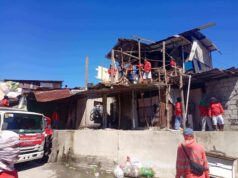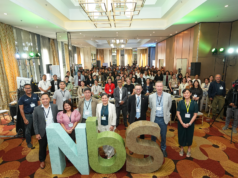CLARK FREEPORT — Some P30 million to P192 million have been estimated as the value of the “scrap” materials derived from at least 16 recently demolished buildings within the aviation complex here, but Aeta leaders who were supposed to be the beneficiaries denied yesterday they received that much.
“What we got was P15,000 and 100 sacks of rice and that was in 2009,” Aeta Robert Rivera, president of the Bamban Aeta Tribal Association (BATA), told the Punto! yesterday. He said the benefits his group got were from the sales of materials from only two demolished buildings.
Clark International Airport Corp. (CIAC) chairman Nestor Mangio said that in his meeting with Rivera and other Aeta tribal folk the other day, they insisted they never received more than the P15,000 and the 100 sacks of rice since last year.
In a telephone interview, Mangio said as many as 17 buildings have already been demolished, most of them only recently. He cited a member of the demolition team as estimating that scraps derived from the buildings could be worth about P30 million.
But Candaba Mayor Jerry Pelayo, who holds a usufruct contract covering two buildings in the area, said that the materials were of high quality and that engineers had valued them at about P192 million.
He said the demolitions scuttled his plans to use some of the buildings for agriculture projects to help Kapampangan farmers, as he disclosed plans to file plunder charges against those involved in the demolitions.
CIAC president Victor Jose Luciano, in a press conference here the other day, admitted he authorized the demolition of the unused buildings left by the Americans in this former US air force base, following a series of letters and telephone calls from Presidential Management Staff (PMS) and the Presidential Action Center (PAC) in Malacanang.
Luciano said that PMS was following up the request of BATA, led by Rivera, for donations of scrap materials to be obtained from two unused buildings within the jurisdiction of CIAC covering 2,500 hectares of this freeport, including the Diosdado Macapagal International Airport (DMIA).
The first letter dated June 23, 2009, signed by then PMS head Hermogenes Esperon Jr. , was addressed to Luciano. “Please be informed that the Office of the President has approved the request of Mr. Oscar Rivera, chairman, Bamban Aeta Tribal Association, for donation of DMIA’s old buildings and other old materials for their livelihood programs.”
At the press conference, Luciano distributed copies of another letter from the Presidential Action Center dated April 26, 2010 and signed by Director Bobby Dumlao, inquiring into what action he had taken on the certain request of another Aeta, Catalino Saplala. But the letter did not specify whether the request also pertained to donations of materials from more demolitions.,
Luciano insisted that all proceeds from the sale of scraps from a total of 16 buildings already demolished, mostly recently, were supposed to go to the Aetas.
Still, he noted that “the Aetas deal with scrap dealers in the demolition, and CIAC had nothing to do with the matter beyond that.”
Rivera said that at least in the case of the two buildings demolished last year, a certain Josie Gomez, whom he identified as an associate of Luciano, as the one who signed for them the demolition permit. Pelayo also cited the same name as a contractor for the recent demolitions.
“What we got was P15,000 and 100 sacks of rice and that was in 2009,” Aeta Robert Rivera, president of the Bamban Aeta Tribal Association (BATA), told the Punto! yesterday. He said the benefits his group got were from the sales of materials from only two demolished buildings.
Clark International Airport Corp. (CIAC) chairman Nestor Mangio said that in his meeting with Rivera and other Aeta tribal folk the other day, they insisted they never received more than the P15,000 and the 100 sacks of rice since last year.
In a telephone interview, Mangio said as many as 17 buildings have already been demolished, most of them only recently. He cited a member of the demolition team as estimating that scraps derived from the buildings could be worth about P30 million.
But Candaba Mayor Jerry Pelayo, who holds a usufruct contract covering two buildings in the area, said that the materials were of high quality and that engineers had valued them at about P192 million.
He said the demolitions scuttled his plans to use some of the buildings for agriculture projects to help Kapampangan farmers, as he disclosed plans to file plunder charges against those involved in the demolitions.
CIAC president Victor Jose Luciano, in a press conference here the other day, admitted he authorized the demolition of the unused buildings left by the Americans in this former US air force base, following a series of letters and telephone calls from Presidential Management Staff (PMS) and the Presidential Action Center (PAC) in Malacanang.
Luciano said that PMS was following up the request of BATA, led by Rivera, for donations of scrap materials to be obtained from two unused buildings within the jurisdiction of CIAC covering 2,500 hectares of this freeport, including the Diosdado Macapagal International Airport (DMIA).
The first letter dated June 23, 2009, signed by then PMS head Hermogenes Esperon Jr. , was addressed to Luciano. “Please be informed that the Office of the President has approved the request of Mr. Oscar Rivera, chairman, Bamban Aeta Tribal Association, for donation of DMIA’s old buildings and other old materials for their livelihood programs.”
At the press conference, Luciano distributed copies of another letter from the Presidential Action Center dated April 26, 2010 and signed by Director Bobby Dumlao, inquiring into what action he had taken on the certain request of another Aeta, Catalino Saplala. But the letter did not specify whether the request also pertained to donations of materials from more demolitions.,
Luciano insisted that all proceeds from the sale of scraps from a total of 16 buildings already demolished, mostly recently, were supposed to go to the Aetas.
Still, he noted that “the Aetas deal with scrap dealers in the demolition, and CIAC had nothing to do with the matter beyond that.”
Rivera said that at least in the case of the two buildings demolished last year, a certain Josie Gomez, whom he identified as an associate of Luciano, as the one who signed for them the demolition permit. Pelayo also cited the same name as a contractor for the recent demolitions.
Inquiries made by Punto! at the CIAC public affairs and the engineering office revealed that CIAC had no employee named Josie Gomez.
Mangio said that the “matrix” of the CIAC on the powers of Luciano is not clear on his authority to donate properties, even without CIAC board approval.
Luciano himself admitted this, adding that in a recent meeting, the CIAC board cited that his donation was made in good faith.
Mangio, however, noted that the donations seemed to have violated Commission on Audit Circular No. 96003 issued in 1996 and Department of Budget Circular No. 425 issued in 1995 covering procedures on government property disposal.
Luciano claimed that the demolitions were carried out only after the Building and Utilities Regulatory Department (BURD) of the Clark Development Corp. (CDC) certified the buildings were unsafe.
But BURD assistant manager Angel Pineda said his office issued demolition clearance largely on the basis of Luciano’s request. “We just make sure that minimum safety standards are in place, but otherwise, we trust that the requesting party who has jurisdiction in the area knows better and have other plans for the sites,” he said.
Pelayo denied allegations that the demolished buildings were no longer usable. “They were made of high grade materials that could last many more years,” he said.
“Those buildings could have been put to good use, such as warehouses or dormitories for workers in call centers. I had proposed a food terminal in some of them so that agricultural projects from northern provinces could find market in Clark instead of going farther to Metro Manila,” he said.
Luciano himself admitted this, adding that in a recent meeting, the CIAC board cited that his donation was made in good faith.
Mangio, however, noted that the donations seemed to have violated Commission on Audit Circular No. 96003 issued in 1996 and Department of Budget Circular No. 425 issued in 1995 covering procedures on government property disposal.
Luciano claimed that the demolitions were carried out only after the Building and Utilities Regulatory Department (BURD) of the Clark Development Corp. (CDC) certified the buildings were unsafe.
But BURD assistant manager Angel Pineda said his office issued demolition clearance largely on the basis of Luciano’s request. “We just make sure that minimum safety standards are in place, but otherwise, we trust that the requesting party who has jurisdiction in the area knows better and have other plans for the sites,” he said.
Pelayo denied allegations that the demolished buildings were no longer usable. “They were made of high grade materials that could last many more years,” he said.
“Those buildings could have been put to good use, such as warehouses or dormitories for workers in call centers. I had proposed a food terminal in some of them so that agricultural projects from northern provinces could find market in Clark instead of going farther to Metro Manila,” he said.



